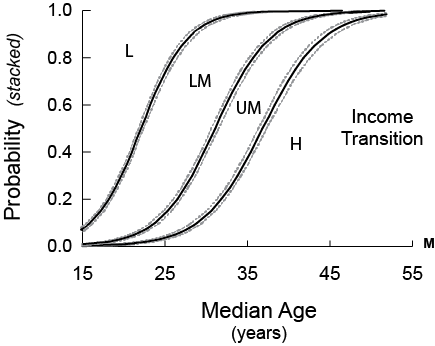Per-capita Income Transition (comprising 3 models, shown below in Fig. 1 and Table 3)
The age-structural model of per-capita income (GNI per capita, $US, Atlas Method), uses the World Bank’s four per-capita income classes (Fig. 1), the range of which is adjusted annually as prior-year income values are adjusted for inflation: low (L), lower-middle (LM), upper-middle (UM), and high (H). The current set of models uses the World Bank’s 2018 revision of its categories, which refers to 2017 levels of US$.
The logistic regression analysis of the income sector indicates that:
- states with populations under 5.0 million are likely to attain all categories at younger median ages than more populous states,
- states relying on natural resource wealth (>15% of GDP) are likely to attain all categories at younger median ages than non-resource reliant states; and
- states in the low and lower-middle income categories that have been involved in a high-intensity conflict (>1000 battle-related deaths per year) are likely to enter categories later than others. Note that most conflicts (both high and low intensity) occur within states in the low and lower-middle income categories.
- that the point at which 50 percent of all countries are expected to be within the lower-middle income category, or a higher category (upper-middle or high) is at a median age of 21.8 (±0.3) For the upper-middle income category, that point is at 30.4 (±0.4) years, and for the high category, at 36.0 (±0.6) years.


